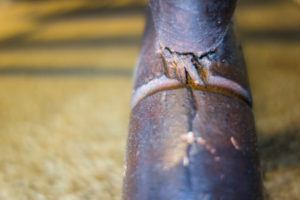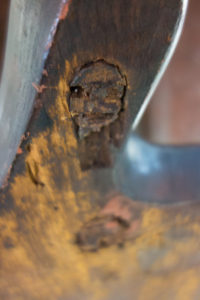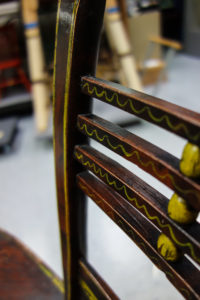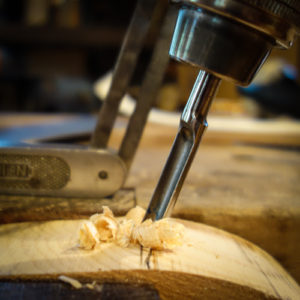How do you get a spoon bit to keep from wandering? What’s the best way to prevent tear-out with a spoon bit?
We are all victims of a post-industrial mindset and we all ask these questions. But these questions miss the point. Lets look at some photos of holes that were drilled by spoon bits in an early 19th C. chair writing arm chair in Colonial Williamsburg’s collection that I recently copied:
The pre-industrial chairmaker would probably have considered this work to be perfectly average, or even above average. It seems to me that if spoon bit tear-out were the only tool marks on the chair, if the finish was polished to a mirror surface, then the tear-out would look like quite a mistake. But the whole chair is built with variation and tool marks all over it. To my eyes, at least, it is quite attractive.
Spoon bits are a sheer joy to use – the chips alone are one of woodworking’s great wonders. Spoon bits are also fast. Their speed rivals a bradpoint in a cordless drill.
Spoon bits can cut much cleaner than what you see in the photos above. In fact, I couldn’t get any of my bits to tear as badly as what I found on the old chair. And believe me, I tried. I think I just wasn’t working fast enough – I couldn’t totally shed my 21st century idea of what ‘good work’ meant. But spoon bits will never cut as cleanly as a bradpoint in a power drill. Or, in many places, an auger bit in a bit brace.*
If I ever switch to using spoon bits in my daily chairmaking, it will be because I am tired of throwing a cordless drill out every few year, tired of listening to the stupid thing whine. I’m getting close.
*As the angle of the hole and the diameter of the bit increase, auger bits tend to start tearing and splitting the mortise mouth.





[…] favorite answer is to adjust your expectations. But there are some tips that will give you more control. I’ve never used […]
Elia,
Did you ever get around to writing up how to position holes accurately with a spoon bit? I’m thinking of using a spoon bit to create hollows for carving gouge handles to sit in (with the sharp bit held to a back board with a magnet) and am having a heckuva time getting them accurate to within an eighth. On a bad day, a quarter. :-/
An attached photo of the best I’ve been able to do. I’ve been drilling a pilot hole with a 1/8 inch twist bit, then enlarging that with a 1/2 inch countersink bit, then using that to get the 1 inch spoon bit starred. With some steering, I only miss by about an eighth or two.
If you need really accurate locations of the hole, you could try a cook’s patent bit (or it’s cousin, a scotch-eye bit). They pop up on Ebay occasionally and are like a spoon bit with a lead screw. You can see a photo here: https://handtoolwoodworking.com/review-of-chairmaking-drill-bits/
Thanks for the reminder! I started that post, then forgot about it. I’ll finish it up in the next couple weeks. Elia
Thanks, Elia! With some practice I’ve been getting better. Here’s an in-progress photo of the door of my carving tools / chisel till, which has a grand total of 63 1 inch holes (five rows of tools, 12 or 13 per row), matched up with magnets to hold the sharp ends of the tools. I had a couple spaced poorly, but for the most part, I got pretty good at steering the bit as I went. This particular piece will be the outside of one of the two doors, and these six holes were the last ones I drilled.
So, how do you get it to center around a mark? I never know exactly where to place the 5/16 bit to start the hole.
There’s a number of tricks to help – I’ll be writing a post about this soon (I hope). Elia